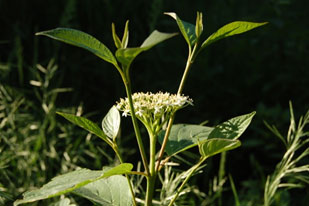Redtwig Dogwood in the Landscape

Stephen Love, University of Idaho
Scientfic Name: Cornus sericeaCommon Name: Redtwig Dogwood
Description: Redtwig dogwood is a moderate to large-sized deciduous shrub. The defining characteristic of this species is the bright red color of the stems, although less colorful forms with green or yellow stems are also fairly common. The stem color is especially prominent in winter when the leaves do not hide the color. Redtwig dogwood has bright green leaves that turn red in fall. In spring, large clusters of flowers appear, leading to the development of small white berries that are loved by many birds. At maturity, the plants grow to a height of 6 to 8 feet. As the plants age, they become wider than tall. Photograph complements of Larry Rupp, USU.
Native Habitat: Redtwig dogwood is typically a riparian species native to much of the western and northern United States. It grows with many other streamside species at a wide range of elevations.
Cultural Requirement
Soil: Grows best in heavier soils with relatively high water holding capacity. Adapted to a range of soil pH.
Moisture Tolerance: Redtwig dogwood thrives in consistently damp or regularly irrigated sites. However, although not a xeric plant, it is surprisingly tolerant of dry conditions and can be placed where minimal supplemental irrigation is supplied.
Sun/Shade/Preference: Grows under a range of sunlight conditions from full sun to fairly heavy shade. Can serve effectively in the understory of large trees.
Transplanting: Tolerant of long periods in pots and is very easily transplanted from pot-to-pot or into the garden. Can be transplanted anytime from early spring to late fall.
Propagation: Can be propagated from seed but needs to be clonally propagated to maintain the character of the original mother plants. Very easy to produce from rooted cuttings. Self-layered stems can frequently be found around mature plants. These can be planted directly into the garden and will establish easily if watered frequently until well-rooted.
Maintenance (pruning, fertilization, deadheading, division, irrigation, etc): Provide supplemental irrigation every 10 to 14 days during the hot part of the summer. Prune in the spring to control size, if needed, and occasionally thin out old "barky" and dead stems.
Insect, disease, or other problems: Redtwig dogwood will occasionally develop black stem cankers on pruned or wounded branches. These can be pruned out as needed. Otherwise, the species has no serious pest or disease problems.
Landscape Value
Use in the Landscape: Redtwig dogwood can serve many roles in the landscape. It is dense enough to serve as a screen plant. It is effective as a low element in a windbreak planting. It is sufficiently attractive to serve as a specimen plant, especially when positioned to take advantage of the red stem color during winter months. This species also provides fill and understory in locales with tall trees. The dense cover and food berries are very attractive to birds and small mammals.
Foliage: The leaves are glossy and dark green. Fall color is red and can be quite spectacular. The youngest stems on the plants are often bright red.
Flower: Flowers are not a prominent feature of the plants, but do add to the appeal of the species. The small, white flowers grow in large clusters and mature into small, white berries.
Timing: May, June
Color: White.
Fruit: White berries with few seeds.
Form: Large globular to spreading shrubs.
Texture: Moderately coarse.
Ultimate Size: Plants reach a height of 6 to 8 feet. Mature plants may be 12 feet or more wide. Dwarf varieties are available.
Rate of Growth: Grows rapidly and will reach mature size in 5 to 6 years.
Suggested Plant Partners: Redtwig dogwood looks nice with moderate to large-size native deciduous trees, such as Acer grandidentatum, Betula occidentalis, and Quercus gambelii or around large, open conifers, including Pinus ponderosa and Pinus strobiformis. Wildflowers with similar water needs, such as Aquilegia coerulea and Monarda fistulosa, also make good partners.
Availability: Routinely available as potted plants at most native or traditional nurseries.
Cultivars: 'Flaviramea' (yellow-twig), 'Cardinal' (red-twig), 'Insanti' (compact), 'Kelseyi' (dwarf), 'Silver' and 'Gold' (variegated leaves)
References:

